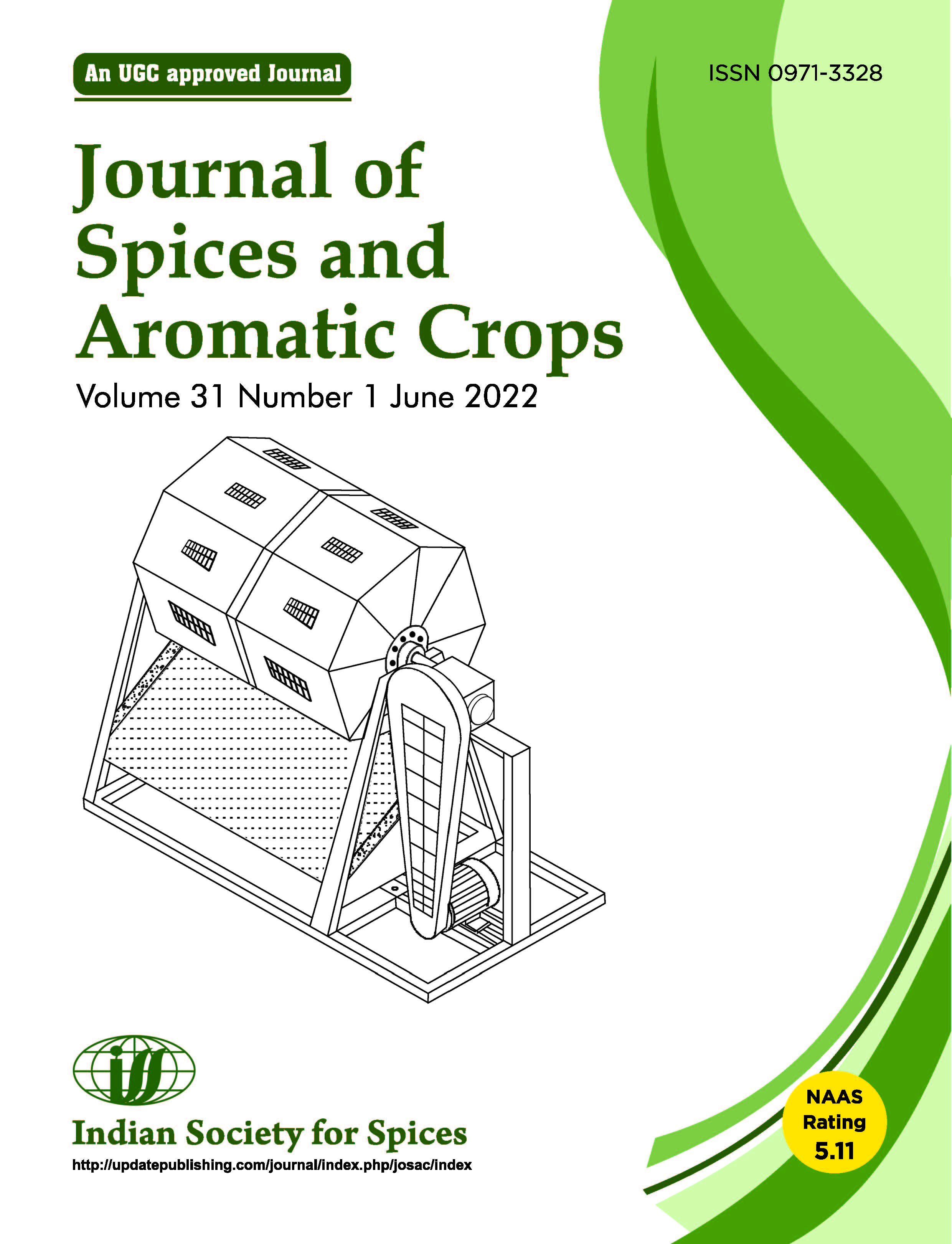Estimates of genetic variability, inter character association and path analysis in turmeric over environments
Variability and association in turmeric over environments
DOI:
https://doi.org/10.25081/josac.2022.v31.i1.7553Keywords:
Curcuma longa, curcumin, dry recovery, heritability, locationAbstract
Pooled data of 27 traits, including quantitative and qualitative, from 15 turmeric varieties grown in three locations over two years were used to estimate the genetic parameters of variability and path analysis. High genotypic coefficient of variation (GCV) combined with high phenotypic coefficient of variation (PCV) was observed for collar girth, length of mother rhizome, number of mother rhizomes, weight of mother rhizome, weight of primary rhizome, number of secondary rhizomes, primary rhizome inter-nodal length, bisdemethoxycurcumin (BDMC), demethoxycurcumin (DMC), curcumin (CUR) and yield. High heritability coupled with high genetic advance as per cent mean (GAM) was recorded for plant height, number of shoots, leaf petiole length, leaf length, collar girth, length of mother rhizome, girth of mother rhizome, primary rhizome inter-nodal length, dry recovery, oleoresin, BDMC, DMC and curcumin. Correlation coefficients showed that yield was significantly associated with collar girth, weight of mother rhizome, number of primary rhizomes, weight of primary rhizome and number of secondary rhizomes. Path coefficient analysis at phenotypic level revealed that, positive direct effect was high for length of mother rhizome followed by number of mother rhizomes, weight of primary rhizome and curcumin content. The study confirmed that characters such as weight of mother rhizome, girth of mother rhizome, weight of primary rhizomes, number of primary rhizomes and curcumin content can be relayed upon to form selection criteria in turmeric.
Downloads
References
Aarthi S, Suresh J & Prasath D 2018 Variability and association analysis of curcumin content with yield components in turmeric (Curcuma longa L.). Electron. J. Plant Breed. 9 (1): 295–303.
ASTA 1975 Official method of analysis. 12th Edn. Association of Official Analytical Chemists, Englewood Cliffs. Washington D.C. pp. 21.
ASTA 2004 Curcumin content of turmeric spice and oleoresin. Official Analytical Methods, second ed. ASTA, New York, pp. 51.
Bahadur V, Yeshudas V & Meena O P 2016 Nature and magnitude of genetic variability and diversity analysis of Indian turmeric accessions using agro-morphological descriptors. Can. J. Plant Sci. 96: 371–381.
Corcolon E A & Dionisio-Sese M L 2014 Genotypic diversity of turmeric (Curcuma longa L.) accessions in Mindanao, Philippines on the basis of curcumin content. J. biodivers. environ. sci. 5(4): 593–600.
Dewey D R & Lu K H 1959 A correlation and path coefficient analysis of components of wheat grass seed production. Agron. J. 51: 515–518.
Goulden C H 1952 Some distance properties of latent root and vector methods used in multivariate analysis. Biometrika 53: 325–338.
Gupta A K, Mishra R & Lal R K 2016 Genetic Variability and Character Interrelationship among Indigenous Germplasm of Turmeric (Curcuma longa). J. Herbs spices & med plants 22 (2): 190–201.
Jayashree E, Kandiannan K, Prasath D, Sasikumar B, Senthil Kumar CM, Srinivasan V, Suseela Bhai R & Thankamani C K 2015 Turmeric (extension pamphlet). Indian Institute of Spices Research, Kozhikode, pp 12.
Johnson H W, Robinson J F & Comstock R E 1955 Estimates of genetic and environmental variability in soybean. Agron. J. 47: 314–318.
Manivannan N 2014 TNAUSTAT-Statistical package. Retrived from https://sites.google. com/site/tnaustat.
Maurya R, Pandey V P, Yadav S, Singh A & Yadav S 2018 Genetic variability studies in turmeric (Curcuma longa L.). Int. J. Chem. Stud. 6(4): 1960–1962.
Mishra R, Gupta A K, Lal R K, Jhang T & Banerjee N 2015 Genetic variability, analysis of genetic parameters, character association and contribution for agronomical traits in turmeric (Curcuma longa L.). Ind. Crops Prod. 76: 204–208.
Nair R R & Aarthi S 2018 New approaches in turmeric (Curcuma longa L.) breeding. In: International symposium on biodiversity of medicinal plants and orchids; Emerging Trends and Challenges. pp. 39–40.
Nazeem P A & Menon R 1994 Blossom biological and hybridisation studies in turmeric (Curcuma spp.). S Indian Horti. 43:161–167.
Prajapati K N, Patel M A, Patel J R, Joshi N R, Patel A D & Patel J R 2014 Genetic Variability, Character Association and Path Coefficient analysis in Turmeric (Curcuma longa L.). Elect. J. Plant Breed. 5(1): 131–137.
Robinson H F, Comstock R E & Harvey P H 1949 Estimates of heritability and the degree of dominance in corn. Agron. J. 41:353–359.
Sadanand, Misra S, Ranjan N K, Kumar A, Sengupta S, Kumar R & Nath S 2019 Evaluation of genetic parameters of different varieties of Turmeric (Curcuma longa L.) under Ranchi condition. J. pharmacogn. phytochem. SP5: 200–204.
Sivasubramanian S & Menon, P M 1973 Genotypic and phenotypic variability in rice. Madras. Agric J. 60: 1093–1096.
Verma R K, Pandey V P, Solankey S S & Verma R B 2014 Genetic variability, character association and diversity analysis in turmeric. Indian J. Hort. 71(3): 367–372.
Published
How to Cite
Issue
Section
Copyright (c) 2022 S Aarthi, J Suresh, D Prasath

This work is licensed under a Creative Commons Attribution-NonCommercial-NoDerivatives 4.0 International License.






 .
.